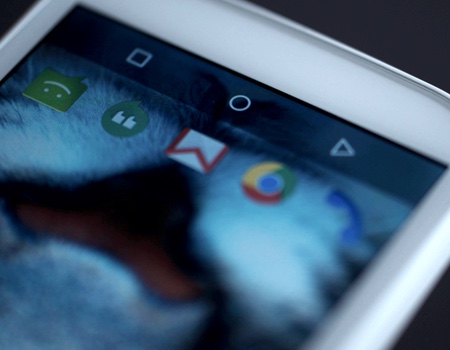
This week there has been a lot of talk about those virtual buttons, although it is something that could have been debated a long time ago. There are smartphones, like the Samsung, with physical buttons on the phone frame, and others like the Nexus 6, which have the buttons on the touch screen itself, virtualized. Which ones do you prefer? Which are better?
How much do the buttons occupy?
Perhaps all this debate has arisen as a result of a small study that has been dedicated to analyzing how much space these virtual buttons occupy on the screens of different smartphones that have virtual buttons, a study that our colleagues from another blog also analyze. Under this paragraph you have the graph in which you can see the data in the case of the Nexus 6, the LG G3, the HTC One M8 and the Sony Xperia Z3, even reaching 7,2% in the HTC One M8, and 6,1% in the case of the Nexus 6. That is what we lose from the screen. Although, do we really lose it?
Losing screen
Many users prefer physical buttons, because virtual buttons take up space on the screen, space that after all could be used to be occupied by other elements of the interface. In the case of the Samsung Galaxy Note 4, or the Samsung Galaxy S6, with physical buttons, that does not happen. Subtracting what the touch buttons occupy according to the previous study, we can conclude that most of the time the Nexus 6 has a useful 5,7-inch screen. Still, that is the case with a very large smartphone. In the case of the HTC One M8, the usable screen with these active buttons is just 4,7 inches.
Even so, the screen is bigger
In any case, many applications and other functions of the smartphone have the possibility of using the full screen, such as when watching movies or playing video games. In these cases we have the screen completely occupied by these, and then we are making the most of it, being able to do without the physical buttons, not as in the case of the Samsung. The question is, when do we want more screen? In common moments in the interface when we look at settings, or browse on Twitter, or when we watch a movie or play a video game? If it is the latter case, then the virtual buttons win the game over the physical buttons.
The physical button space
Still, there is one thing to keep in mind. The fact of not having physical buttons does not imply that this space ceases to exist on smartphones. The Nexus 6, for example, has a speaker under the screen. The HTC One M8 bears a stripe with the company logo, something similar to what happens with the LG G3. And the Sony Xperia Z3 does not include anything, but it does have a frame in that section. If these companies worked to be able to locate physical buttons in that space, it would be better used, and they would leave more free screen. To all this we must add the new fashion for fingerprint readers. Except in the case that we place them behind, they will have to be located on the front, as it seems that will happen with the new HTC One M9 +, occupying a space under the screen.
My opinion
I don't like the fact that the virtual buttons don't provide as clear a response as the physical buttons, and that it's so easy to accidentally press them. But even so, I prefer that they are virtualized on screen, to be able to do without them and make the most of the screen. However, this is more a theoretical question, because I only prefer them that way when the space under the screen is used to, for example, put a speaker, or something like that, because to put a logo, I prefer the touch buttons. And in any case, I think the buttons on the interface are not so necessary. In Apple they only have one button, the central one, and it could even be located on the side, or behind, as in the case of LG. I think that combining all the things on the market, there is technology to launch a mobile without buttons on the front, neither on the screen nor outside of it. In any case, what do you think about it?


On screen if frames are adjusted.
I prefer them physical, by far, I hate pressing them wrongly, or that in a full screen app, I have to be making gestures so that they appear and sometimes they do not appear or take time to show, it is really uncomfortable, leaving aside that in a way or another IF they steal screen space
It depends on the frames. In the LG G3 they look quite good because the screen is used a lot, while in the HTC One M8 and M9 they take space from the screen in addition to the fact that there is space to put them in the frame.
If you can remove the frames and make them virtual, I go for the virtual ones, otherwise physical buttons without thinking about it